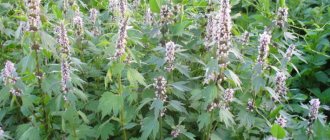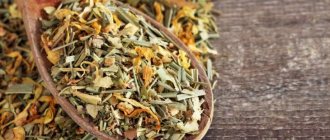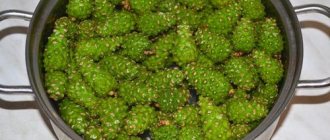Hawthorn fruits and flowers are extremely beneficial for health. Their properties are used for the prevention and treatment of diseases of the heart, blood vessels, normalization of blood pressure and digestion, against fatigue and insomnia, and to eliminate the consequences of nervous strain. Berries of wild varieties were used in Ancient China and Asia. In the 16th century, cultivated plant species were developed. At first, the beneficial properties of hawthorn eliminated loose stools due to dysentery. Then they began to use it to improve the functioning of the heart and the condition of blood vessels.
Composition of medicinal plant
The exact chemical composition that explains the beneficial properties of hawthorn is still unknown. It is believed that the therapeutic effect is due to flavonoids, plant polyphenols. They give fruits color, help eliminate fragility of blood vessel walls, and neutralize free radicals in the body.
- quercitrin maintains elasticity, reduces capillary permeability, has antitumor and antioxidant effects;
- Quercetin is a wonderful means of preventing and treating cerebrovascular disorders and cardiovascular diseases. Sufficient intake of quercetin reduces the risk of cataract formation.
- hyperoside increases the utilization of glucose, increases the use of oxygen, enriches the heart with potassium ions, increases the contractility of the myocardium, the middle layer of the heart muscle, and the magnitude of cardiac output.
- Vitexin dilates blood vessels, accelerates metabolic processes in the heart muscle.
Hawthorn flowers and fruits are beneficial due to the properties of the acids they contain:
- Ursolova has a wound-healing and anti-inflammatory effect;
- oleanolic acid tones and enhances blood supply to the heart and brain;
- chlorogenic has an anti-sclerotic effect, is useful for normalizing kidney and liver function, and has a choleretic effect.
- Coffee tea has pronounced antibacterial properties and promotes the secretion of bile.
The fruits of the plant contain a lot of carotene, provitamin A, as well as vitamins C, E, K. Some varieties are comparable in the amount of carotene in the berries to carrots or rose hips. The fruits contain sugars, as well as sorbitol, which is recommended in case of diabetes.
High content of potassium, calcium, magnesium, iron, as well as microelements manganese, copper, zinc.
Freezing reduces the amount of tannins, the berries become sweeter and less tart.
The action is the same, but the composition is different
The chemical composition of flowers and fruits is significantly different, but, nevertheless, both are used for diseases of the cardiovascular system.
Hawthorn flowers have a high content of essential oil (1.5%), and therefore they are more effective and better help with functional disorders of the heart. In addition, they contain tannins (2.9-9.6%), flavonoids (acetylvitexin, hyperoside, quercetin, vitexin, bioquercetin, pinnatifidine, 8-methoxykaempferol). Blood red hawthorn flowers have a high content of potassium (32.1 mg/g) and magnesium (3.4 mg/g), which are very important for the normal functioning of the cardiovascular and nervous system.
The biochemical composition of the fruits of different types of hawthorn is somewhat different, but in general they contain 4-11% sugars (mainly fructose), 0.26-0.93% malic acid, 60-180 mg% triterienic acids, 0.59-0. 61% pectin, 0.84-1.73% tannins and dyes, about 3.4% coumarins, including oxycoumarins, which reduce the prothrombin index. In addition, they contain up to 25 mg% ascorbic acid, 380-680 mg% vitamin P, 2-14 mg% carotene, and in some types up to 5% vitamin E. Dried fruits are rich in sorbitol (up to 22.5%), and in Central Asia, when ground, they are added to the dough of flat cakes.
About 2.5% of flavonoids are present in the flowers of hawthorn monopistillate, including hyperosil (0.7%), flavones, as well as procyanidins (3.7%), caffeic and chlorogenic acids, triterpene acids.
Hawthorn pentapalm
Triterpene acids (0.45%) were found in the fruits of hawthorn (0.45%), including ursolic and oleic acid, p-sitosterol, chlorogenic and caffeic acids, saponins and flavonoids. In addition, hyperoside, hyperin, tannins, sorbitol, choline and fatty oil were found. The leaves contain chlorogenic and caffeic acids; in flowers - ursolic, oleanolic, caffeic, chlorogenic acids, quercetin, quercitrin and essential oil, up to 0.16%. The seeds contain the glycoside esculin (krategin). The leaves of hawthorn pentapistillate contain flavonoids and saponins.
A comparative study of Caucasian hawthorn (C. caucasica), b. eastern, b . small-leaved (C. microphylla), b. false-leaved (C. pseudoheterophylla), b. Meyer (S. meyeri), b. Shovits (C. szovitsii), b. pentafestal ( C. pentagyna), b . hairy-flowered (C. eriantha). Phytochemical research has shown that hawthorn pentapalm is closer in composition to the Caucasian hawthorn and contains alkaloids, glycosides, essential oils, resinous substances, sugary substances, fatty and tannin substances, bitterness and B vitamins. In hawthorn flowers, unlike fruits , contains the largest amount of essential oils. In terms of its effect on the heart and antihypertensive properties, hawthorn pentapistillate turned out to be the most active. The sum of saponins was isolated from dry fruits and leaves of hawthorn pentapistillate; the sum of flavonoids and anthocyanins was isolated from fresh hawthorn fruits.
Medicinal properties of hawthorn
Taking the fruits and flowers of the plant in the form of infusion, tincture, or decoction benefits the entire body and has a complex effect on various organs and systems.
Heart . Hawthorn has a vasodilating effect, benefits the ability to tone the heart muscle, and ensure sufficient oxygen supply. Reduces frequency, establishes rhythm, increases the strength of heart contractions. Reduces the excitability of the heart, relieves fatigue, improves coronary blood flow and cerebral circulation.
Medicinal forms of hawthorn are useful in reducing the manifestations of mild forms of atrial fibrillation and tachycardia.
Vessels . The plant normalizes blood clotting, cholesterol levels, and prevents the formation of atherosclerotic plaques. It is used in case of vascular spasm.
Nervous system . It has a sedative (calming, but without the onset of drowsiness) effect; the useful plant reduces the excitability of the nervous system, helps eliminate insomnia, and helps normalize sleep.
Digestive system . Taking infusions and tinctures helps with gastritis in any form, flatulence, and in case of difficult digestion in children. They are used to eliminate loose stools.
Flowers and fruits of the plant help cope with headaches , dizziness, and shortness of breath. The antioxidant effect prevents the formation of tumors of various natures, improves immunity, and helps to quickly restore strength after infectious diseases.
Nursing mothers use the beneficial property of hawthorn to stimulate milk production .
The use of the plant in cosmetics helps restore the natural moisture of the skin, tones, relieves swelling, and eliminates the manifestations of age-related changes.
Possible side effects
Systemic side effects during the treatment of hawthorn are not excluded, since its bioactive substances are absorbed into the blood and distributed to all organs and tissues. They are observed rarely, usually when the dosage regimen determined by the doctor is not followed or when the decoction, tea, or infusion is inappropriately taken. Systemic reactions are clinically manifested as follows:
- nausea;
- increased heart rate;
- drop in blood pressure;
- drowsiness;
- dizziness;
- headache;
- flatulence;
- disorders of intestinal motility.
Local adverse reactions are manifested by angioedema and irritation of the skin and mucous membranes. If any negative effect occurs, you should stop using hawthorn and seek medical help to eliminate symptoms.
Pharmacy products
To prepare medicines with a number of useful properties, flowers and fruits of common hawthorn, prickly, blood-red and other small-fruited species are usually used. They have been better studied and contain a significant amount of compounds that normalize heart function.
Hawthorn fruits are produced in various dosage forms: plant materials, powder, lozenges, tincture, extract. They are useful for eliminating arrhythmia, they are used to calm the central nervous system, lower cholesterol levels, normalize blood clotting, increase milk production, and eliminate digestive disorders in infants.
Flowers have a better ability to lower blood pressure than fruits.
Hawthorn tincture is prepared from crushed dry fruits in 70% alcohol.
Cardiovalen , drops for oral administration, due to the adonizide, valerian tincture, and hawthorn extract included in the composition, are useful in increasing the force of heart contractions and have a sedative effect.
Valemidin , alcohol drops to eliminate spasm of smooth muscles of blood vessels and internal organs, have a sedative effect.
Fitorelax , available in tablet form, contains valerian rhizome and hawthorn flower extract. It is beneficial due to its sedative properties, helps to cope with insomnia and increased nervous excitability.
Cedarvit in the form of an elixir, a non-dosed liquid dosage form, tones, increases the body's resistance to harmful influences, and helps to quickly cope with fatigue. Contains flowers and fruits of hawthorn, birch buds, pine nuts, honey, chokeberry berries.
Amrita , an elixir in the form of a mixture of alcohol-water extracts of plant materials of rose hips, elecampane, ginger, cardamom, juniper, thyme, licorice and hawthorn. Its benefits and medicinal properties are tonic and restorative effects.
Demidov syrup has a choleretic effect, eliminates spasm of smooth muscles, reduces the formation of gases during flatulence, and stimulates peristalsis. Contains hawthorn fruits, calamus, birch buds, oak bark, oregano.
How to brew hawthorn at home. Juice, tea, infusions, tincture
During the season, it is useful to drink diluted juice from fresh fruits. It improves blood circulation and normalizes the functioning of the digestive system.
Hawthorn tea recipe.
- In the evening, put 20-30 berries in a thermos, you can add rose hips, and brew 1 liter of boiling water.
In the morning, healthy tea is ready. It is better to brew the fruits whole, as this way they retain more benefits.
An infusion is prepared from the dried fruits and flowers of hawthorn, which have many beneficial properties.
Homemade hawthorn infusion recipe:
- Brew whole berries with boiling water and leave overnight in a thermos at the rate of a couple of handfuls of fruit per 1 liter of boiling water.
Take a third of a glass an hour before meals 3-4 times a day. Its properties are useful for arrhythmia, angina pectoris, and for eliminating nervous excitement.
If you chop the berries, you can prepare the infusion faster:
- Brew 1 tsp. chopped berries with a glass of boiling water. After half an hour, the home remedy is ready.
Take 1/3 glass an hour before meals.
Hawthorn tincture . Prepared from crushed dried fruits or flowers:
- Infuse 4 tbsp. vegetable raw materials in 2 glasses of vodka for two weeks, strain.
Take 25-30 drops with water an hour before meals.
The flower tincture has more medicinal and beneficial properties for getting rid of hypertension and angina pectoris.
Application in cosmetology
The shrub can be used to create mixtures that care for the face. Since the composition contains ursolic acid, which stimulates increased collagen regeneration, hawthorn masks have excellent anti-aging properties.
In addition, hawthorn helps tighten pores, enhances blood flow and cell nutrition, and eliminates acne and swelling.
Furuncle on the face causes and treatment. Is it possible to have a boil?
Hawthorn helps maintain the beauty of hair. It strengthens, restores hair, activates its growth and treats dandruff.
Eliminating bags under the eyes with hawthorn
This recipe is also useful for those who want to remove swelling on the face. To prepare the composition, you will need dry hawthorn leaves (1 tsp), which are poured with boiling water (0.1 l) and left for 30 minutes. Then the product is filtered and divided into 2 parts. One of which is slightly heated, and the other is diluted with ice water (2 tbsp. L.).
The procedure involves the use of cotton pads dipped into solutions. Warm and cold compresses are applied alternately to the eye area for 1 minute. They need to be changed several times, completing the procedure cold.
Rejuvenating and nourishing face mask
It is necessary to grind fresh hawthorn berries (2 tbsp) in a blender and add olive oil (1 tbsp). The composition is evenly distributed on the skin of the face and after 20 minutes is closed with warm water. After the procedure, cream is applied to the face.
Dandruff treatment
A mixture of hawthorn tincture (2 tbsp), castor oil (1 tbsp) and the juice of half a lemon will help you get rid of dandruff quickly and reliably. The mixture is applied to the hair roots and left for 1 hour. After which the hair is washed with shampoo.
Hair loss treatment
To prepare the product, you need to grind aloe leaves (30 g). In order for the plant to be as healing as possible, the leaves are first kept in the refrigerator. Then the crushed aloe is added to vodka (0.1 l.). Hawthorn berries (30 grams) are also placed there. The infusion is kept in a dark place for 7 days.
Apply the product using massage movements to the scalp and hair roots. Then the head is covered with cellophane and a terry towel. The mask is left for 40-60 minutes, after which it is washed off without shampoo. The recommended course duration is 1 month with procedures performed every other day.
Hawthorn is used not only in the treatment of various diseases and cosmetology, but also in cooking. Jams and marshmallows are made from it, and added to compotes and baked goods. In China, it is often included in first courses, meat and fish.
Use of hawthorn for heart diseases
The plant is widely used to treat heart diseases. The symptoms are different - increased fatigue, weakness in the absence of physical activity, night rest does not restore strength. Impaired cerebral circulation causes fainting and loss of consciousness. Sudden swelling, shortness of breath, a feeling of tightness in the chest, especially when lying down. If these symptoms appear, be sure to consult a doctor.
Heart failure
When the heart muscle loses the ability to contract strongly, other organs experience oxygen starvation. To normalize blood circulation, take hawthorn, which has the beneficial property of preventing fatigue of the heart muscle and having a tonic and contraction-enhancing effect.
Tea balm with hawthorn:
- Add 2 tbsp to 100g of black tea. rose hips, 1 tsp. hawthorn berries, 1 tsp. motherwort, 1 tsp. peppermint, 1 tsp valerian, 1 tsp. chamomile flowers.
Brew and drink like regular tea.
Hawthorn juice.
- Wash a glass of fresh or thawed fruit after freezing, chop it, add a little water, heat it to +30C. Squeeze out the juice through cheesecloth with a spoon.
Take 1 tbsp. an hour before meals. Use the remaining cake for brewing and preparing infusion.
Hawthorn infusion.
- Brew 1 tsp. crushed fruits with a glass of boiling water, leave for half an hour, strain.
Take half a glass in the morning and at night.
Another way to prepare the infusion:
- Mix 2 parts each of hawthorn and motherwort flowers, add 1 part each peppermint and hop cones. Brew 1 tsp. mixture with a glass of boiling water, leave for half an hour, strain.
Drink a glass during the day. Mint dilates blood vessels, hops soothes.
Coronary heart disease (CHD), angina pectoris and myocardial infarction
If the myocardium, the middle layer of the heart muscle, does not receive enough oxygen, muscle spasm occurs, which accompanies heaviness in the chest and compression.
Coronary heart disease develops due to disruption of the coronary arteries, which supply the myocardium with oxygenated blood. Its common cause is atherosclerosis, the deposition of cholesterol on the walls of blood vessels, and the formation of atheromatous plaques.
The chronic form of the disease, angina pectoris (“angina pectoris”), manifests itself in attacks that are relieved by nitroglycerin.
The acute form of IHD is myocardial infarction.
To prevent coronary artery disease, it is useful to take courses of infusion of hawthorn fruits and flowers, which has the beneficial property of lowering cholesterol levels, normalizing blood pressure and heart rate. For taste, prepare an infusion with rose hips.
To prevent angina pectoris and myocardial infarction, prepare an infusion of hawthorn and motherwort.
Recipe 1:
- Mix 1 tsp. crushed berries or flowers with motherwort herb, brew in a glass of boiling water, leave for an hour, strain.
Take 1/3 cup one hour before meals.
Recipe 2:
- Mix 1 part each of hawthorn and motherwort fruits, add 2 parts each of valerian and feinnel fruits, which are useful because they have a calming effect.
- Brew 1 tsp. collect a glass of boiling water, simmer in a water bath for 15 minutes. Let cool, strain.
Take 1/3 cup 2 hours after meals.
Infusion for angina from berries:
- Brew hawthorn at the rate of 1 tbsp. fruits for 1 glass of boiling water, leave overnight in a thermos. In the morning, drain the infusion and squeeze the berries through a cloth.
Take a glass one hour before meals.
Recovery after myocardial infarction:
- Take 2 times a day 1/2 cup of hawthorn juice and 1 tsp. vegetable oil. After a while, take a weak infusion of berries instead of tea.
Does hawthorn increase or decrease blood pressure?
The medicinal plant benefits from its ability to normalize high or low blood pressure, so it is used in recipes for hypertension and hypotension.
Recipes for high blood pressure
In case of hypertension, the risk of stroke and heart attack is increased. High blood pressure may indicate kidney disease.
The beneficial property of hawthorn to reduce blood pressure is used in a folk remedy recipe:
- Mix 1 tsp. crushed fruits, as well as motherwort, dried cucumber, add some dried chamomile flowers. Brew a glass of boiling water. After an hour, strain the infusion.
Take 1 tbsp. an hour before meals.
Another remedy is prepared from hawthorn flowers:
- Dried vegetable raw materials at the rate of 1 tbsp. Brew in a glass in the evening, leave overnight in a sealed container.
Take 1 glass an hour before meals for a month.
Other recipes for high blood pressure:
- Mix 3 parts each of hawthorn and motherwort flowers, 2 parts chokeberry fruits, 1 part sweet clover. Brew at the rate of 1 tbsp. collection per glass of boiling water. Leave overnight in a thermos.
Take a third of a glass an hour before meals.
- Mix 3 tsp. hawthorn flowers and 2 tsp. medicinal herb, it is useful because it normalizes vascular tone and blood clotting. Pour the mixture with three glasses of cold water. Bring to a boil, leave for 5 hours.
Take a glass one hour before meals.
A simple recipe for hypotension
With low blood pressure, weakness and dizziness; hypotensive people do not tolerate heat well. Their well-being is improved by sufficient physical activity. An infusion of hawthorn flowers and fruits helps maintain tone:
- Brew a glass of boiling water 2 tsp. dried crushed berries and 1 tsp. flowers, strain after two hours.
Take 1 glass one hour before meals or 2 hours after meals.
Possible harm and contraindications
Hawthorn tincture is prepared on the basis of ethyl alcohol, so the product is contraindicated in the following cases:
- Pregnancy.
- Lactation period.
- Children under 12 years of age.
- Low blood pressure.
- Arrhythmia.
- Liver dysfunction.
- Brain diseases.
Among the side effects that hawthorn can cause are:
- Reduced blood pressure.
- Dizziness.
- Urticaria-type rash.
- Skin itching.
- Slowing heart rate.
How does hawthorn affect the pulse?
Hawthorn extract slows down the heart rate. The drug is prescribed for the treatment of tachycardia.
Treatment of vascular diseases and atherosclerosis with hawthorn
The walls of healthy blood vessels are elastic and easily change tone. Cholesterol deposits and decreased elasticity reduce the lumen and make it uneven, as with varicose veins. As a result, the organs do not receive the required amount of oxygen, and its outflow is disrupted.
Recipe for the prevention and treatment of varicose veins:
- Mix 3 parts of hawthorn and oregano flowers, 4 parts each of St. John's wort and motherwort. Brew 1 tbsp in the evening. mixture with a glass of water, leave overnight.
Take 1/2 cup one hour before meals.
Another composition helps:
- Mix 1 part each of hawthorn berries, chamomile flowers, oregano, kidney tea, 2 parts each of peppermint and motherwort. Brew 1 tbsp overnight. mixture with a glass of boiling water.
Take 1/2 cup an hour before meals.
Damage to cerebral arteries by atherosclerosis causes stroke, renal arteries – hypertension, coronary arteries – coronary artery disease.
The causes of the disease are poor lifestyle, metabolic disorders, thyroid disease, which increases cholesterol levels in the blood. Cholesterol, a natural fatty alcohol, is needed by the body in certain quantities; it is produced by the liver.
Using the beneficial properties of hawthorn flowers against atherosclerosis.
Flower infusion recipe:
- Brew 1 tsp. dried flowers, leave for 15 minutes, strain.
Take 1/2 cup half an hour before meals. When using fruits, leave in a thermos for 2 hours. Take 1-2 tbsp. an hour before meals.
Recipe for preventing ischemic heart disease and stroke:
- Mix 2 parts each of hawthorn and rose hips, 1 part each of chokeberry fruits and carrot seeds. Brew 3 tbsp. mixture with a liter of boiling water, leave for 3 hours.
Take 1/2 cup 6 times a day.
Recipe for atherosclerosis:
- Chopped hawthorn berries at the rate of 1 tbsp. cook cham in 0.5 liters of water over low heat, add 2 tbsp. granulated sugar.
Keep refrigerated. Take 1 tbsp. an hour before meals and at night.
The benefits of hawthorn for overwork and stress relief
The medicinal properties of flowers and fruits are used to prevent the health of the heart and blood vessels, normalize blood pressure, and cope with nervous fatigue.
Constant tension and concentration during the working day tires the nervous system, causes increased blood pressure, increases heart rate, irritability, headaches, and disrupts sleep.
Hawthorn fruits are useful because they reduce the excitement of the nervous system, dilate blood vessels, improve cerebral and cardiac circulation, and increase the supply of oxygen.
To fall asleep better, sleep soundly, and wake up rested:
- In the morning, brew some berries in a thermos.
You can take ready-made tea at night, with honey.
- Brew 1 tsp. berries with a glass of boiling water, leave in a thermos for 1 hour.
Take 3 tbsp. 3-4 times a day an hour before meals.
Tea made from hawthorn and St. John's wort berries has the ability to eliminate anxiety and irritability:
- Mix crushed fruits and herbs in equal quantities, brew 1 tbsp. mixture with a glass of boiling water.
After 15 minutes the tea is ready.
How to use berries
Dried berries are already ready for use - they are equally useful as long as they are stored in the house. Tinctures, teas, and vitamin solutions for external use are prepared from the dried product.
Tinctures and tea can be drunk or pre-infused so that the solution is more concentrated. Another option is to grind the berries using a coffee grinder and then pour boiling water over them. After the mixture has infused, it is filtered or drunk finely ground. A cold, fortified drink is useful in summer; it also quenches thirst well.
Treatment of metabolic disorders with hawthorn
The quality of nutrition of a modern resident is far from ideal due to the consumption of low-quality or poorly combined foods. Insufficient intake of fresh vegetables and fruits prevents the intestines from regularly getting rid of harmful substances. As a result, metabolic processes are disrupted, cholesterol levels are increased, blood pressure is increased, and heart function is impaired.
With gastritis, the gastric mucosa is inflamed. To eliminate heartburn and other unpleasant manifestations of the disease, an infusion of hawthorn and peppermint is beneficial:
- Mix and brew 1 tsp. each component with a glass of boiling water.
After half an hour, the infusion is ready.
Disruption of metabolic processes causes stagnation in the gallbladder and the formation of stones. The liver cleanses the blood of harmful substances worse, and the general condition of the body worsens.
An infusion of hawthorn flowers has the benefit of normalizing metabolic processes. It is used in the treatment of diseases of the digestive system:
- Brew a glass of boiling water 1 tbsp. flowers, leave for an hour.
Take 1/4 cup one hour before meals.
Who should not take hawthorn decoction? Contraindications for use
Despite its benefits, doctors do not recommend taking the decoction to some people.
It is contraindicated for those whose work requires concentration and complexity. The occurrence of weakness and drowsiness is possible when using drugs that contain it, doctors warn.
This occurs due to a decrease in blood pressure and heart rate. This phenomenon is temporary and occurs until the body gets used to new conditions.
A contraindication for using hawthorn decoction is also taking medications against arrhythmia. The combination of these drugs will not bring benefit, but harm to the body.
Doctors do not recommend using hawthorn preparations for women during pregnancy and nursing mothers. Individual intolerance in pregnant women is common. In addition, medications cause increased uterine tone, which threatens miscarriage.
A contraindication for using hawthorn decoction is also taking medications against arrhythmia. The combination of these drugs will not bring benefit, but harm to the body. High acidity and stomach ulcers are contraindications for taking medications prepared from hawthorn.
Don't miss useful advice from doctors about: Sinusitis: symptoms and treatment at home
Carefully! Healers warn that drinking cold water after drinking an infusion or decoction will cause intestinal spasms.
Treatment of prostatitis
Hawthorn is useful in preventing prostate adenoma. It is believed that its appearance is associated with age-related changes in hormonal levels. In addition to discomfort in the lower abdomen, the disease causes fatigue and irritability.
Drinking hawthorn tea normalizes sexual function, calms and improves heart function.
The collection is useful for men:
- Mix 1 part each of hawthorn and peppermint flowers, 2 parts of Veronica officinalis, 3 parts each of fireweed and knotweed flowers. Brew 1 tsp. mixture with a glass of boiling water, leave for 20-30 minutes.
Take 1/3 cup one hour before meals.
Hawthorn varieties
The ancient plant is distinguished by a variety of species; it grows in different countries. In Russia and the CIS, the most common varieties are blood-red (Siberian), prickly (ordinary), and one-pistillate (one-stone). Daurian, Altai, Ukrainian and many other varieties are grown, which are used for the prevention and treatment of various diseases.
Blood red (Siberian)
Shrub or small tree up to 4 m high with straight, sparse long (up to 5 cm) spines. Flowering is short-lived, 3-4 days in May-June, and is accompanied by an unpleasant smell of stale fish.
Round berries 8-10 cm with 3-4 seeds are edible, they are distinguished by a sour taste, and ripen in September-October. The first harvest is harvested in the 7th year or later.
The plant is unpretentious, tolerates frost and drought, and poor soil. Lives 300-400 years. It is often used in hedges. In the wild, it is common in the taiga of Siberia, in the Far East near sources of moisture.
Spiny (common)
Grows as a shrub or tree up to 5m. Hawthorn berries are small, approximately 1 cm in diameter. It is characterized by slow growth and is distributed in the wild throughout Europe.
It is shade-tolerant, undemanding to soil composition, and easily tolerates cutting and shaping. It is widely used to create difficult-to-pass natural fences.
Single-pistillate (single-stone)
Popular in the southern and central regions of Russia, found in Central Asia and the Caucasus. Unlike the prickly variety, it grows quickly. Lives up to 200-300 years. Tree 3-6m high. The spines are sparse, 1 cm long. The berries have one seed. Fruiting begins after 6 years.
Forms many shoots and tolerates shearing easily. A lot of decorative varieties have been developed. They are distinguished by the shape of the crown, leaves, absence of thorns, and constant flowering.
Features of a medicinal plant
Hawthorn is a deciduous, semi-evergreen, tall shrub (rarely a small tree) from the Rosaceae family.
In the wild, it occurs either singly or in compact groups. His “favorite” places are forest edges, clearings, clearings, and screes. In excessively moist soil, hawthorn roots can rot, so it grows mainly in deep, moderately moist and well-drained soil. The perennial plant is unpretentious, so homeowners willingly use it for decoration. Delicate hawthorn flowers are attractive in spring, and tart red fruits are attractive in autumn. Both of them have medicinal properties. So, the plant not only decorates gardens, but is also used to combat various diseases.
Planting, propagation and care. Creating a hedge
Hawthorn is propagated by stratified seeds (kept in the cold before germination), root suckers and cuttings, layering, grafting.
Propagation by seeds (from seeds) is used if a hedge is needed, since with this method the beneficial properties of the hawthorn variety are lost. Seeds from slightly unripe fruits are planted in the fall. It is advisable to be thicker, since many do not germinate. Before planting in the spring, the seeds are kept for several months at a temperature of +1..+3C.
In the first year, the seedling grows 10-12 cm. In the second or third year, when it reaches half a meter in height, the first pruning of the plant is performed. 3-6 lower buds are left, which is why the side shoots begin to grow intensively. They are also cut off, leaving no more than two.
Seedlings are planted in a permanent place at the age of two, so they take root well. They should not be placed next to apple, pear, or plum trees - these plants have common pests.
Dig a hole 50x50cm, the distance between holes is up to 2m. Pour a fertile layer of soil onto the bottom, add humus and mineral fertilizers. Deepen the root collar by 3-5cm. Water well and keep the soil moist for two weeks.
In the future, regularly trim the bush, give it shape and height.
Hawthorn requires sun to bear fruit. Otherwise, the plant is drought and frost resistant. The first harvest is harvested after 5-6 years. Fruiting is usually annual or every other year. One plant produces up to 20 kg of berries.
The “thorny” properties of hawthorn are useful when growing the bush as a hedge. Seedlings are planted in trenches 50-70cm deep and 50cm wide. The distance between bushes should not exceed 50cm. They are formed by cutting to half the length of the annual growth. In autumn, superphosphate and potassium salt are added.
How to prepare hawthorn for winter
Most hawthorn species tolerate cold and frost quite calmly. But some varieties, for example, common hawthorn, are difficult to tolerate cold, since their shoots and buds are capable of freezing. It is quite difficult to cover an adult tree in winter, so we recommend using only frost-resistant species for planting in cold regions. By the way, you can buy these in our online seedling store!
Previous:
- Columnar pear
- Columnar cherries, planting and care
- Raspberry pruning
- Moles on the site
- Pruning ornamental shrubs
Preparing flowers and fruits for the winter
The beneficial properties of hawthorn flowers in the treatment of a number of diseases are more effective than those of the fruits. Therefore, they are also prepared for the winter.
The main enemy when harvesting flowers is high humidity. Dry weather required. Harvesting is complicated by the short flowering period, often 2-3 days.
Fully opened flowers are harvested. They are carefully cut off along with a small part of the stem. It is better in the morning, when the dew has completely dried. Spread the harvested crop in a thin layer in a dry, shaded and well-ventilated place.
Store dried flowers for up to a year in fabric bags, paper bags, or wooden boxes lined with paper.
To preserve the beneficial properties of hawthorn fruits as much as possible, they are picked in dry weather in September-October. After sorting and washing, the berries are dried at temperatures up to +50C. They darken and wrinkle, acquiring a sweet, astringent taste. Store in the same way as flowers for up to two years.
Hawthorn berries prepared for the winter are also stored in the freezer. Lightly dry the sorted and washed fruits on a towel, then place them in plastic containers with a lid.







